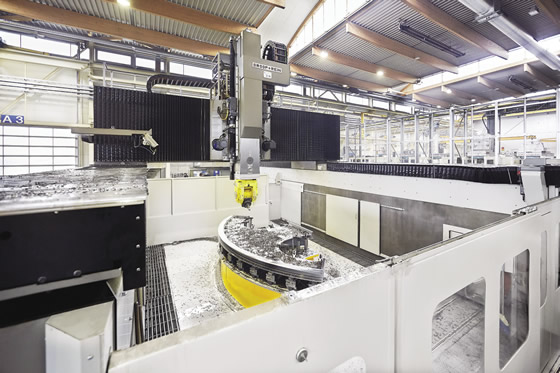
Courtesy of Starrag
The Droop+Rein high-speed, multifunction machining center from Starrag has an additional turning table and performs 5-axis machining with a fork-type head.
Heavy-duty multitask machine tools provide numerous benefits for producing large, complex components—when the application is right.
Some metalworking terms are hard to pin down: “high-performance cutting tools,” “micromachining” and “high-speed metal removal” mean different things to different people. “Heavy-duty multitasking” is another elusive term.
Peter Beyer, director of product strategy and development for machine tool builder Fives Giddings & Lewis, Fond du Lac, Wis., indicated the starting point for “heavy-duty” spindle power is roughly 37 kW (50 hp). “In the minds of most people, that’s a heavy-duty or high-power machine.”
Workpiece size also comes into play. “We consider Giddings & Lewis to be a supplier of machine tools for large parts and we start around 1m,” Beyer added.
Richard Parenteau, director of application development at Methods Machine Tools Inc., concurred that machines accommodating workpieces 1m (39.4 ") in length and longer qualify as heavy duty, as well as those with a 12 " (304.8mm) and larger chuck. The Sudbury, Mass., machine tool supplier offers, for example, the Nakamura-Tome Super NTXL multitask machine, which handles parts up to 2m (78.7 ") long and 15.5 " (393.7mm) in diameter. (See photo below.)
He placed the B-axis power requirements in the 25- to 30-hp (18.4 to 22.1 kW) range. “That’s certainly more than adequate to do the kind of milling that needs to be done,” Parenteau said.
Other offerings extend the workpiece size capacity, such as the Multus B750 multifunction horizontal lathe from Okuma America Corp., Charlotte, N.C. (See photo on below.) The multitask machine provides up to 6m (19.7 ') of bed length and has a maximum turning diameter of 1,050mm (41.34 ") and a 50-hp milling spindle.
“When you get into multitasking, builders typically have to make some compromises,” said David Fischer, product specialist for Okuma. “The goal of the Multus was to not make those compromises. We designed it so the milling capability would be the same as one of our large horizontal milling machines and the turning would be comparable to our large turning centers.”
That’s achieved, in part, by starting with a heavy-duty, cross-ribbed cast iron base as the rigid foundation, Fischer explained. “You can have a very powerful milling spindle but if you don’t have the iron to back it up, you create problems because you start moving the column or B-axis around.”
Eye on Applications
The large parts produced in these massive machines cut across a wide swath of industries, but components for energy extraction and generation are common. They include housings for fracking pumps, wind turbine parts and valves and shafts for oilfields.
Those workpieces are often high-strength materials, such nickel-base alloys, which require a machine with high torque in the main spindle that can also impart fine surface finishes and achieve tight form tolerances, said Georg Hanrath, executive vice president of Starrag AG, Rorschacherberg, Switzerland. (Starrag USA Inc. is located in Hebron, Ky.)
One option the machine tool builder offers for meeting these requirements is its horizontal machining centers with facing heads, as well as vertical turning machines with payload capacities from 20 to 350 tons for making parts such as power generator housings, Hanrath added. “Besides the main application, turning of the assembled housings, the flanges between the housing parts must be milled and bored with high accuracy.”
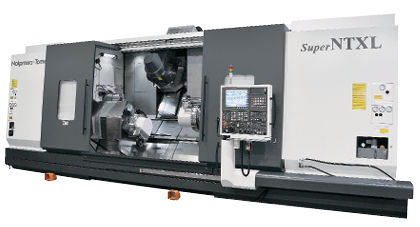
Courtesy of Methods Machine Tools
The Nakamura-Tome Super NTXL multitask machine handles parts up to 6.56’ long and 15.5 " in diameter.
For vertically aligned arts, Fischer emphasized aerospace applications. “A lot of the aerospace parts aren’t long, but they’re big in diameter and can be very complex.”
The type of workpiece materials also runs the gamut, but their hardness tends to peak at about 55 HRC for these large, multifunction applications, according to Parenteau.
“Large, heavy parts might be casehardened to prepare for multitask machining,” said Dale Hedberg, Feeler product manager for Methods Machine Tools Inc. “However, heat treating these parts is typically not required for multitask operations.”
Multitask Menu
Parenteau added that parts machined via heavy-duty multitasking are predominantly ground after heat treating, but not on the same machine. Many customers ask Methods about grinding on multitask machines. Machines that have B-axis spindles with a maximum speed from 8,000 to 12,000 rpm are capable of grinding, but he noted the machines aren’t designed for the swarf that grinding generates. “That can create maintenance and warranty issues for the machine. You can do it, but we don’t endorse it,” he said, adding that it would require an expensive filtration system designed for grinding swarf and probably a centrifuge to remove the grinding partials. “With a proper system, we would support the machine warranty.”
On the other hand, Giddings & Lewis offers a grinding attachment on its vertical lathes for customers who want to impart fine finishes without tool marks and enable size control that turning might not provide, Beyer said.
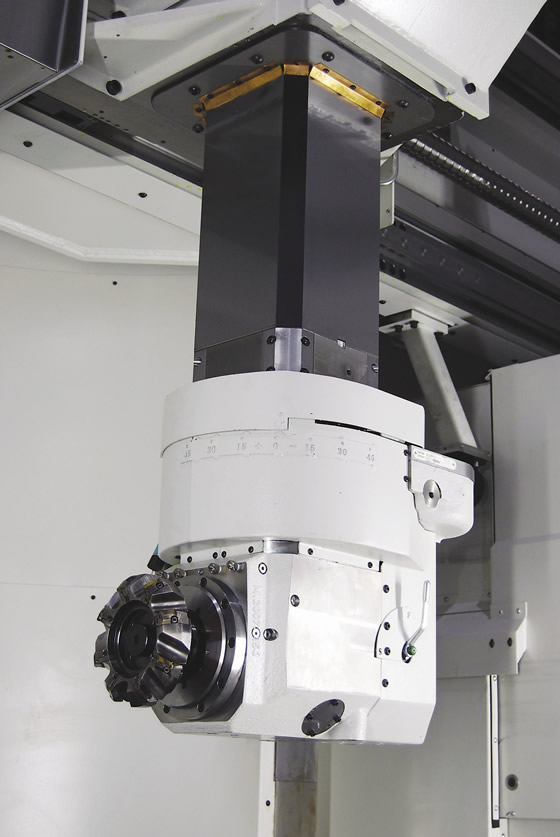
Courtesy of Fives Giddings & Lewis
Fives Giddings & Lewis’ Y-axis attachment brings off-centerline turning, milling, drilling and tapping capabilities to its vertical turning centers.
In addition to grinding, as well as milling, on its multifunction vertical turning lathes, Starrag also offers polishing capabilities, Hanrath noted. Other Starrag options include grinders that can turn and drill, and machining centers with optional microforging.
Multitask machines of all sizes are commonly called mill/turn machines, but that doesn’t necessarily mean the milling and turning tasks are equally divided. According to Hedberg, multitasking means primarily turning and some milling. “A few of the traditional milling machine manufacturers have tried adding turning capabilities with limited success,” he said. “The greatest success is with turning centers that add milling capabilities.”
Giddings & Lewis, for example, enables off-centerline turning, milling, drilling and tapping on its vertical turning centers with a Y-axis attachment that combines a C-axis head with a table and X- and Z-axis motions. “This is an affordable way to reduce setups and free up machine time on the horizontal machining centers and boring mills that used to be required to produce these same features on turned parts,” Beyer said.
In addition, the machine tool builder offers an extended-range contouring head for its horizontal boring mills to produce large, turned features with a repeatability of ±0.005mm (±0.0002 ") and an accuracy of ±0.015mm (±0.0006 ").
“If the percentage of turning versus milling is small, or the part is highly unbalanced or difficult to fixture, it makes more sense to do turning operations by spinning the tool on a boring mill than by spinning the part on a lathe,” Beyer explained, noting most parts produced on a multitask machine are predominantly turned or predominantly milled.
Benefits for Big
While getting a part of any size done in one setup on a multitask machine provides numerous advantages compared to producing it on multiple machines, minimizing part movement is particularly attractive for big pieces with complex features. A key benefit of heavy-duty multitasking is reducing nonproductive time due to part changeover, according to Hanrath. He noted setup times for parts weighing more than 50 tons with high accuracy requirements can consume a full shift.
Hanrath said the other main benefit is reducing part inaccuracies caused by clamping errors, because single setups permit machining features with significantly tighter feature-alignment tolerances. “Moreover, features often should be created in the orientation in which the part is later used to avoid the influence of part deformations.”
Okuma’s Fischer concurred that a machine operator must be highly skilled to avoid misaligning or scrapping a workpiece when moving it from machine to machine using a conventional process, and handling a large, heavy, cumbersome part multiple times creates opportunities for additional errors. “You don’t want to kill a part because the operator didn’t clock it properly, and setup times can be huge because you’re just doing one or two parts in a lot of cases,” he said, adding that machining a part in a single machine eliminates those potential problems.
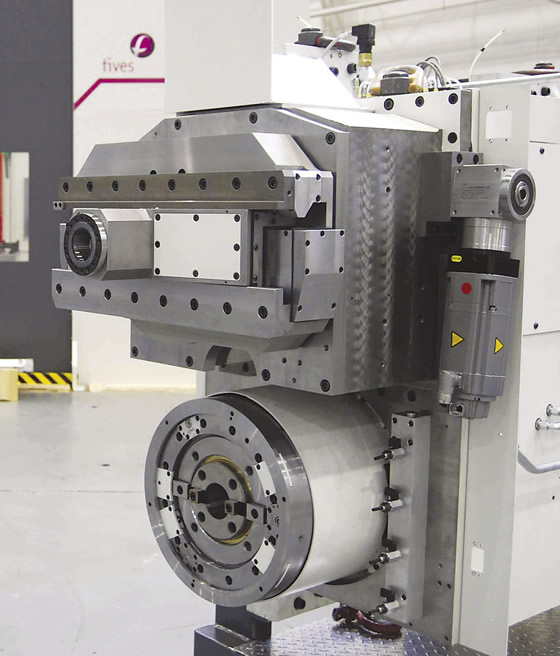
Courtesy of Fives Giddings & Lewis
The integrated contouring head from Fives Giddings & Lewis enables a boring mill to turn large part features, particularly ones for the energy industry.
Methods’ Parenteau emphasized that achieving geometric tolerances is a primary benefit of heavy-duty multitasking. Moving a part to a second machine might involve making a custom fixture, for example, to properly orient the part for machining a secondary feature.
“That goes away in a multitask machine because the orientation is already there,” he said. “The centerline is generated—it’s right on center—and the machine knows exactly where that is. From a geometric tolerancing perspective, putting that secondary feature in is very easy for the machine tool.”
In addition to increasing the part’s accuracy by making it in one setup, Giddings & Lewis’ Beyer said a primary benefit is cost reduction when an end user buys one multitask machine instead of two or more other types of machines. Also, one machine will likely consume less floor space than two.
Take Five
Machining all the features on a large, complex part in one setup generally requires accessing all part faces, but that doesn’t always mean simultaneous 5-axis capability is needed. “You want to have 5-axis capability on the machine,” said Methods’ Parenteau. “The control has 5-axis capability, so the machine is capable, but when you get right down to it, there are very few applications that require a true 5-axis cut. Four axes can usually do 99.9 percent of what you might think may need five.”
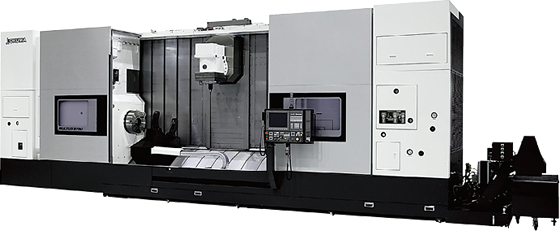
Courtesy of Okuma America
The Multus B750 multitask horizontal lathe from Okuma America provides up to 6m (19.7 ') of bed length and has a maximum turning diameter of 1,050mm (41.34 ") and a 50-hp (37 kW) milling spindle.
Nonetheless, a machine that doesn’t perform “true” 5-axis cuts can be limited compared to one that does. One example is a machine with a wedge Y-axis instead of a true Y-axis. A wedge Y-axis is the Y-axis on a turning center and is usually on top of the X-axis, requiring both axes to move simultaneously to achieve the Y-axis position, Parenteau explained. In contrast, a true Y-axis is directly 90° to the X-axis and moves independently. As a result of the compound-axes move, the wedge Y-axis machine is slightly less accurate, its speed is slower and feed is lower when performing a 5-axis cut compared to a true Y machine.
Although full 5-axis capability is available, Fischer noted Okuma typically offers 4+1 capability on its heavy-duty multitask machines because full 5-axis contouring is often not necessary. “You just need the capability to position that B-axis and do the work you need to do.”
Rotary tables and 1D and 2D head attachments are available to position massive parts and expose multiples sides to the spindle for machining various surfaces. “The static and thermal accuracy, as well as the stiffness and dynamic behavior, of those attachments is a key success factor for accurate, high-performance cutting,” Starrag’s Hanrath said, noting the company offers rotary tables up to 12m (39.4 ') in diameter.
When designing a large multitask machine tool, Giddings & Lewis takes a modular approach. It custom configures the machine rather than custom engineering it to shorten the lead time and ensure build quality with proven, reliable components. “It’s like filling your toolbox with all the right tools,” Beyer explained. “The customer’s particular application will dictate the correct machine travels, table size, pallet changer, work handling equipment, toolchanger, attachments and heads.” He added that the flipside is buying a stock machine and living with its constraints, but it probably won’t provide the best value.
In addition to OEMs, machine shops are incorporating heavy-duty multitask machines to take advantage of their flexibility and gain a competitive advantage by tackling jobs most other shops can’t, Beyer noted.
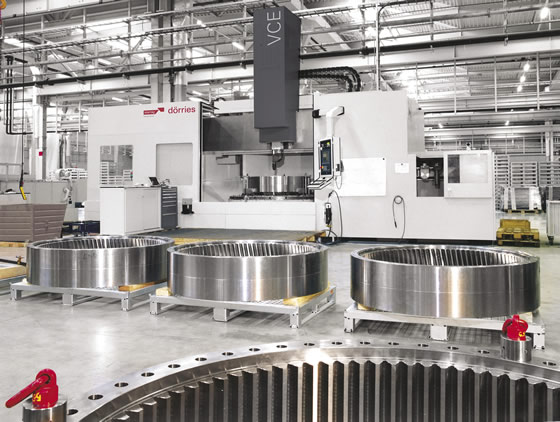
Courtesy of Starrag
Doerries turning lathes from Starrag are equipped with a live spindle to enable milling and drilling.
However, Methods Machine is predominantly selling them to large OEMs for producing a specific product line or family of parts, according to Parenteau and Hedberg. Before making a hefty investment in a massive machine, a customer first has to evaluate whether it’s worth it to multitask or not, Hedberg noted. This generally centers on the machine having enough horsepower and spindle speed to perform the required milling operations.
“Some manufacturers try to build so much flexibility into a machine that it’s not efficient at any one thing,” he said. “However, it is possible to build milling functionality into a lathe that is efficient and reliable.” Hedberg provided the Feeler FVT-1000 vertical turning lathe from Methods with an all-box way design as an example.
Like heavy duty, it’s a challenge to pinpoint exactly when a multitask machine tool is a good value, but machining professionals know it when they see it. CTE
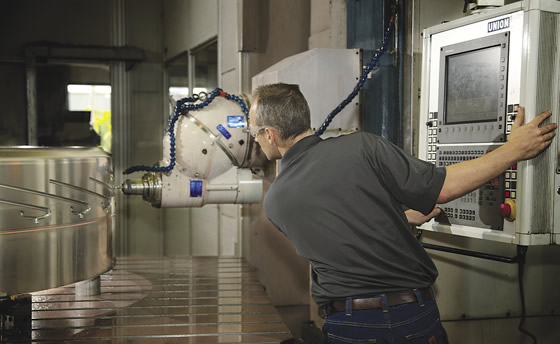
Courtesy of Magna Machine
Magna Machine produces a spiral die for the plastics industry on a multiaxis Union horizontal boring and milling machine.
The 80-ton 'elephant in the room'
Machining a part on different machines might be an option for relatively small parts, but moving workpieces that weigh up to 160,000 lbs. (72,575 kg) from one machine to another is a monumental challenge.
“In a lot of cases, it takes 8 to 12 hours to get parts lined up and fixtured on the table before you even start running the program,” said Scott Kramer, president of Magna Machine Co., about the massive parts the Cincinnati job shop manufactures for power generation, mining, machine tool and amusement park customers.
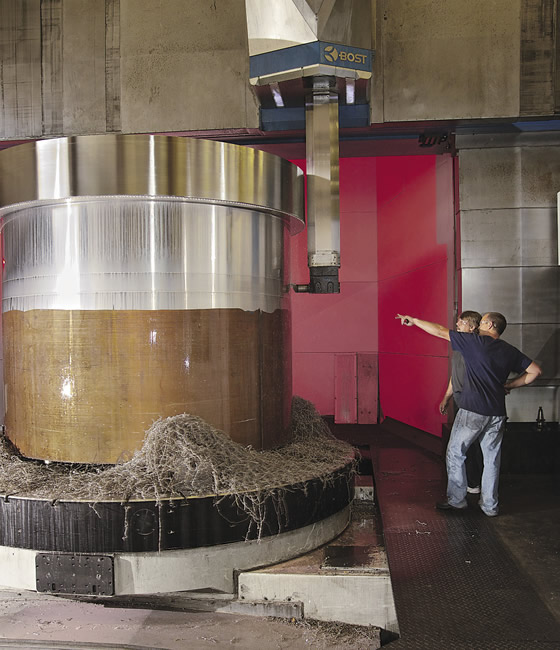
Courtesy of Magna Machine
Magna Machine faces, turns and mills a cylinder mold for the aerospace industry on a Bost VTL 60CY multiprocess machining center.
He’s the third generation to run the company, which was founded in 1947 and has developed a niche for handling huge parts. Magna’s reputation for the big stuff grew as part size increased, and the shop, which has about 120,000 sq. ft. (36,576 sq. m) of production space, purchased its first multitask, or multiprocess, machine tool in 2011 for those applications. The German-made Union PCR-160 CNC horizontal boring mill has turning capabilities, a 120-ton (108-metric-ton) capacity and a 17 "×22 " (431.8mm × 558.8mm) ram. The next year, Magna added a Spanish-made Bost VTL 60 CY traveling-table vertical turning, boring and milling machine with a 236 " (6m) swing and table extensions up to 216 " (5.5m) in diameter, and a Bost T4F horizontal turn/mill machine with a 354 " (9m) center distance and 44,000-lb. (19,958-kg) capacity. Those three machines comprise the shop’s “superbay.”
This year, Magna added a THC 1600 machine from Spanish builder Ibarmia Innovatek to its multiprocess equipment list. Kramer noted the mill/turn machine has a 2-cu.-m (78.7-cu.-in.) work space and a 17,600-lb. (7,983-kg) capacity and—unlike the others that enable five-sided access with 3+2 machining—provides simultaneous 5-axis machining. The capability proves beneficial, for example, when machining engine turbine casings and parts for machines that produce synthetic diamonds because of workpiece complexity and size.
The large multitask machines, as well as most of the other equipment in Magna’s facility, are imported by the shop’s sister company, Cincinnati-based United Precision Services Inc., which also offers machines from Machine Tool Engineering S.A. in Spain. “The sales representatives for United Precision can show and do test cuts on any of the equipment that Magna has in its facility,” Kramer said. In addition, he noted Magna sometimes generates business from prospective machine buyers who visit the “large working showroom.”
Kramer expects Magna’s current multiprocess machines to be making chips for quite some time, and the company plans to retrofit controls and remanufacture the machines as needed to maximize machine life. “They’ll be here probably as long as I will and I have at least another 20 years,” he said.
—A. Richter
Contributors
Fives Giddings & Lewis
(920) 921-9400
www.fivesgroup.com
Magna Machine Co.
(513) 851-6900
www.magna-machine.com
Methods Machine Tools Inc.
(877) MMT-4CNC
www.methodsmachine.com
Okuma America Corp.
(704) 588-7000
www.okuma.com
Starrag USA Inc.
(859) 534-5201
www.starrag.com
Related Glossary Terms
- alloys
alloys
Substances having metallic properties and being composed of two or more chemical elements of which at least one is a metal.
- boring
boring
Enlarging a hole that already has been drilled or cored. Generally, it is an operation of truing the previously drilled hole with a single-point, lathe-type tool. Boring is essentially internal turning, in that usually a single-point cutting tool forms the internal shape. Some tools are available with two cutting edges to balance cutting forces.
- centers
centers
Cone-shaped pins that support a workpiece by one or two ends during machining. The centers fit into holes drilled in the workpiece ends. Centers that turn with the workpiece are called “live” centers; those that do not are called “dead” centers.
- centrifuge
centrifuge
Filtering device that uses a spinning bowl and the differences in specific gravities of materials to separate one from another. A centrifuge can be used to separate loosely emulsified and free oils from water-diluted metalworking fluid mixes and to remove metalworking fluids from chips.
- chuck
chuck
Workholding device that affixes to a mill, lathe or drill-press spindle. It holds a tool or workpiece by one end, allowing it to be rotated. May also be fitted to the machine table to hold a workpiece. Two or more adjustable jaws actually hold the tool or part. May be actuated manually, pneumatically, hydraulically or electrically. See collet.
- computer numerical control ( CNC)
computer numerical control ( CNC)
Microprocessor-based controller dedicated to a machine tool that permits the creation or modification of parts. Programmed numerical control activates the machine’s servos and spindle drives and controls the various machining operations. See DNC, direct numerical control; NC, numerical control.
- family of parts
family of parts
Parts grouped by shape and size for efficient manufacturing.
- feed
feed
Rate of change of position of the tool as a whole, relative to the workpiece while cutting.
- fixture
fixture
Device, often made in-house, that holds a specific workpiece. See jig; modular fixturing.
- gang cutting ( milling)
gang cutting ( milling)
Machining with several cutters mounted on a single arbor, generally for simultaneous cutting.
- grinding
grinding
Machining operation in which material is removed from the workpiece by a powered abrasive wheel, stone, belt, paste, sheet, compound, slurry, etc. Takes various forms: surface grinding (creates flat and/or squared surfaces); cylindrical grinding (for external cylindrical and tapered shapes, fillets, undercuts, etc.); centerless grinding; chamfering; thread and form grinding; tool and cutter grinding; offhand grinding; lapping and polishing (grinding with extremely fine grits to create ultrasmooth surfaces); honing; and disc grinding.
- hardness
hardness
Hardness is a measure of the resistance of a material to surface indentation or abrasion. There is no absolute scale for hardness. In order to express hardness quantitatively, each type of test has its own scale, which defines hardness. Indentation hardness obtained through static methods is measured by Brinell, Rockwell, Vickers and Knoop tests. Hardness without indentation is measured by a dynamic method, known as the Scleroscope test.
- lathe
lathe
Turning machine capable of sawing, milling, grinding, gear-cutting, drilling, reaming, boring, threading, facing, chamfering, grooving, knurling, spinning, parting, necking, taper-cutting, and cam- and eccentric-cutting, as well as step- and straight-turning. Comes in a variety of forms, ranging from manual to semiautomatic to fully automatic, with major types being engine lathes, turning and contouring lathes, turret lathes and numerical-control lathes. The engine lathe consists of a headstock and spindle, tailstock, bed, carriage (complete with apron) and cross slides. Features include gear- (speed) and feed-selector levers, toolpost, compound rest, lead screw and reversing lead screw, threading dial and rapid-traverse lever. Special lathe types include through-the-spindle, camshaft and crankshaft, brake drum and rotor, spinning and gun-barrel machines. Toolroom and bench lathes are used for precision work; the former for tool-and-die work and similar tasks, the latter for small workpieces (instruments, watches), normally without a power feed. Models are typically designated according to their “swing,” or the largest-diameter workpiece that can be rotated; bed length, or the distance between centers; and horsepower generated. See turning machine.
- machining center
machining center
CNC machine tool capable of drilling, reaming, tapping, milling and boring. Normally comes with an automatic toolchanger. See automatic toolchanger.
- metalworking
metalworking
Any manufacturing process in which metal is processed or machined such that the workpiece is given a new shape. Broadly defined, the term includes processes such as design and layout, heat-treating, material handling and inspection.
- milling
milling
Machining operation in which metal or other material is removed by applying power to a rotating cutter. In vertical milling, the cutting tool is mounted vertically on the spindle. In horizontal milling, the cutting tool is mounted horizontally, either directly on the spindle or on an arbor. Horizontal milling is further broken down into conventional milling, where the cutter rotates opposite the direction of feed, or “up” into the workpiece; and climb milling, where the cutter rotates in the direction of feed, or “down” into the workpiece. Milling operations include plane or surface milling, endmilling, facemilling, angle milling, form milling and profiling.
- milling machine ( mill)
milling machine ( mill)
Runs endmills and arbor-mounted milling cutters. Features include a head with a spindle that drives the cutters; a column, knee and table that provide motion in the three Cartesian axes; and a base that supports the components and houses the cutting-fluid pump and reservoir. The work is mounted on the table and fed into the rotating cutter or endmill to accomplish the milling steps; vertical milling machines also feed endmills into the work by means of a spindle-mounted quill. Models range from small manual machines to big bed-type and duplex mills. All take one of three basic forms: vertical, horizontal or convertible horizontal/vertical. Vertical machines may be knee-type (the table is mounted on a knee that can be elevated) or bed-type (the table is securely supported and only moves horizontally). In general, horizontal machines are bigger and more powerful, while vertical machines are lighter but more versatile and easier to set up and operate.
- milling machine ( mill)2
milling machine ( mill)
Runs endmills and arbor-mounted milling cutters. Features include a head with a spindle that drives the cutters; a column, knee and table that provide motion in the three Cartesian axes; and a base that supports the components and houses the cutting-fluid pump and reservoir. The work is mounted on the table and fed into the rotating cutter or endmill to accomplish the milling steps; vertical milling machines also feed endmills into the work by means of a spindle-mounted quill. Models range from small manual machines to big bed-type and duplex mills. All take one of three basic forms: vertical, horizontal or convertible horizontal/vertical. Vertical machines may be knee-type (the table is mounted on a knee that can be elevated) or bed-type (the table is securely supported and only moves horizontally). In general, horizontal machines are bigger and more powerful, while vertical machines are lighter but more versatile and easier to set up and operate.
- payload ( workload)
payload ( workload)
Maximum load that the robot can handle safely.
- polishing
polishing
Abrasive process that improves surface finish and blends contours. Abrasive particles attached to a flexible backing abrade the workpiece.
- stiffness
stiffness
1. Ability of a material or part to resist elastic deflection. 2. The rate of stress with respect to strain; the greater the stress required to produce a given strain, the stiffer the material is said to be. See dynamic stiffness; static stiffness.
- swarf
swarf
Metal fines and grinding wheel particles generated during grinding.
- tapping
tapping
Machining operation in which a tap, with teeth on its periphery, cuts internal threads in a predrilled hole having a smaller diameter than the tap diameter. Threads are formed by a combined rotary and axial-relative motion between tap and workpiece. See tap.
- toolchanger
toolchanger
Carriage or drum attached to a machining center that holds tools until needed; when a tool is needed, the toolchanger inserts the tool into the machine spindle. See automatic toolchanger.
- turning
turning
Workpiece is held in a chuck, mounted on a face plate or secured between centers and rotated while a cutting tool, normally a single-point tool, is fed into it along its periphery or across its end or face. Takes the form of straight turning (cutting along the periphery of the workpiece); taper turning (creating a taper); step turning (turning different-size diameters on the same work); chamfering (beveling an edge or shoulder); facing (cutting on an end); turning threads (usually external but can be internal); roughing (high-volume metal removal); and finishing (final light cuts). Performed on lathes, turning centers, chucking machines, automatic screw machines and similar machines.







